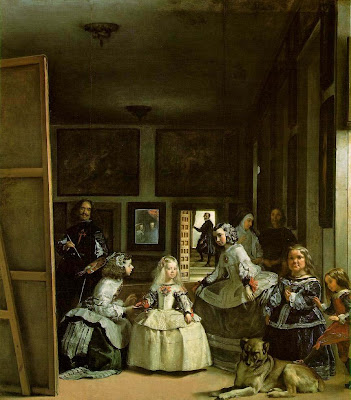 |
| Retrieved August 20, 2011 from : http://www.oneonta.edu/faculty/farberas/arth/Images/110images/sl14_images/velazquez_lasmeninas_large.jpg |
Las Meninas by Diego Velazquez
I have chosen this artwork for my assignment 3 is because I was curious about what the artwork is about. I would like to know more about the events about the artwork. Hence, I started my research on "Las Meninas" which is a masterpiece in Spain.
After researching on this artwork, I found that the artist had drawn himself in the artwork. He wanted to show the Spanish court that painting is an art too. He wanted to get respected and gain high social position.
Diego Velazquez was such a great artist. He used realism and illusionism in this artwork. I never thought that painting of a court can combine these two elements. But, he had used it in his painting.
_________________________________________________________
This is one of the part I did in my Assignment 3 :)
"Las Meninas" was recognized as a Baroque masterpiece in Spanish Golden Age. The artist challenge the concept of reality and illusion.
This artwork had fulfilling the criteria of functionalism. This artwork represented the artist's life at Spanish court. According to Madlyn Millner Kahr, she mentioned that the artist, Velazquez created something truly extraordinary and complex. She wrote that he had a greater intention when doing this artwork, which was to gain titile that ensure him a high place in the society. In 17th century Spain, painting was treated as craft and painters rarely enjoyed high social status. So, he wanted to prove the society that he could be an established painter. In the artwork, he used perspective, value, and colours to make the artwork outstanding. Moreover, he placed himself in the artwork to show that he deserves to be a member of royal family.
Besides that, the artwork had shown the artist's loyalty to the King Philips IV and Spanish court. The artist wanted to obtain recognition from the Spanish court. He was worked with the Spanish royal family for about thirty-three years since the age of 25. This had caused him to have the opportunity to paint the royal family in a furnished room in the palace.
Another criteria which was fulfilling by the artist was imitative. The artwork looked like a snapshot of the scene in a high ceilinged room in the Spanish palace. He had captured the Spanish court and painted it in a very close glimpse. The action in the artwork was frozen for eternity (Kahr). The artist portrayed the elevated presence of Royal such as Princess Margarita, King Philip IV, and Queen Mariana. Princess was physically present while the royal couple were shown in the reflection in the mirror and had God-like presence. (Foucault)
The artist had also used naturalism in the artwork. He illustrated the scenes of everyday life in the Spanish court. From the artwork, we can know that the princess was attended not only by ladies in waiting, but also dwarfs, chaperone, and so on. This showed that the princess was in a protected world. Furthermore, we could know that the dwarfs were considered as "pets" of the princess. This is because the "little people" were often treated as amusement in the court. (Kahr)
No comments:
Post a Comment